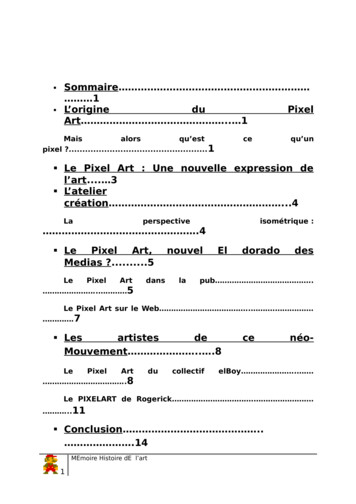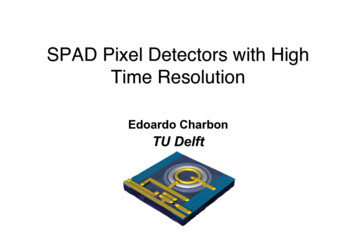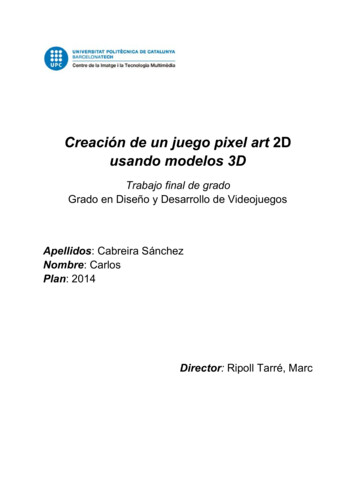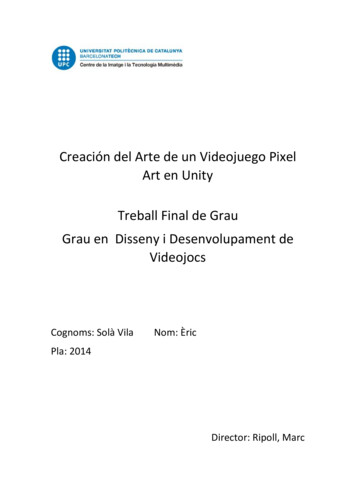Transcription
Journal of Computer Graphics Techniques Vol. 10, No. 2, 2021https://jcgt.orgMMPX Style-Preserving Pixel-Art MagnificationMorgan McGuireUniversity of Waterloo & NVIDIAMara GagiuUniversity of Waterloo(a) Input Image(b) Magnified 2 with Nearest(c) Magnified 2 with MMPXFigure 1. (a) Pixel art combining sprites, text, and UI elements (b) magnified with nearest-neighbor filtering becomes blocky relative to the original pixel size; (c) MMPX filtering refines lines, curves, and patterns for the new resolution, while mostly preserving the palette,transparency, and shape aspects of the original artwork.Input derived from Oryx Design Lab licensed sprites sy-tilesetAbstractWe present MMPX, an efficient filter for magnifying pixel art, such as 8- and 16-bit eravideo-game sprites, fonts, and screen images, by a factor of two in each dimension. MMPXpreserves art style, attempting to predict what the artist would have produced if working at alarger scale but within the same technical constraints.Pixel-art magnification enables the displaying of classic games and new retro-styled oneson modern screens at runtime, provides high-quality scaling and rotation of sprites and rasterfont glyphs through precomputation at load time, and accelerates content-creation workflow.MMPX reconstructs curves, diagonal lines, and sharp corners while preserving the exact palette, transparency, and single-pixel features. For general pixel art, it can often preserve more aspects of the original art style than previous magnification filters such as nearestneighbor, bilinear, HQX, XBR, and EPX. In specific cases and applications, other filters willbe better. We recommend EPX and base XBR for content with exclusively rounded corners,and HQX and antialiased XBR for content with large palettes, gradients, and antialiasing.MMPX is fast enough on embedded systems to process typical retro 64k-pixel full screensin less than 0.5 ms on a GPU or CPU. We include open source implementations in C ,JavaScript, and OpenGL ES GLSL for our method and several others.83ISSN 2331-7418
Journal of Computer Graphics TechniquesMMPX Style-Preserving Pixel Art Magnification1.1.1.Vol. 10, No. 2, 2021https://jcgt.orgIntroductionPixel ArtIn the graphics and gaming community, “pixel art” refers to rasterized graphics elements including sprites, fonts, and whole framebuffer images consistent with thetechnical constraints of 8- and 16-bit consumer computers from the 1980’s and 1990’s,which are now referred to as retro consoles. This style has remained artistically andcommercially important for decades, with increased interest in recent years enabledby retro gaming platforms built on low-cost embedded processors.Figure 1 shows an example of pixel art authored by hand (a), magnified by nearest neighbor filtering (b), and automatically magnified (c)by the MMPX filter introduced in this paper.Magnification is useful for increasing the resolution of existing assets, for scaling the renderedoutput of entire games, or for creating fonts andsprites that represent larger objects beside theFigure 2.A magnified minotauroriginals while approximating a consistent style,stylistically compatible with the origas shown in Figure 2.inal soldier.Pixel art arose from limitations in retro console hardware, such as 8 8 font glyphs, 16 16 or 32 32 individual sprites, 320 240or-smaller screens, and 256 or fewer colors. These are not hard limits on moderndevices, but aesthetic guidelines. Critically, because of the scale and color limitations, image features such as character eyes or hands are often a single pixel, edgesare often jagged instead of antialiased with intermediate shades, and dithering is oftenused to approximate shading and more colors as well as texture. This makes the artstyle extremely sensitive to small artifacts at the pixel scale during rendering, unlikehigh-resolution 3D game rendering or natural images in which individual pixels maychange without significant change to perception of the whole image.The retro consoles include the Nintendo Entertainment System/Famicom (1983),Super Nintendo (1990), Game Boy (1989), Game Boy Color (1998), and Game BoyAdvance (2001); Sega Master System (1985) and Genesis/Mega Drive (1988); Atari7800 (1986), and Commodore 64 (1982).Interest in such platforms has not waned. New hardware and emulator productsmapping pixel-art games to modern hardware include Nintendo’s Switch NES/SNESOnline (2018), the new Nintendo Classic NES (2016) and SNES (2017) consoles,Sega Genesis Mini (2019), PiBoy DMG (2020), Retroid Pocket 2 (2020), Odroid-GOAdvance (2019). See more examples at https://obscurehandhelds.com/.Just as the platforms that display it may be contemporary, pixel-art content itself does not necessarily originate from the 8- or 16-bit era. Many recent games and84
Journal of Computer Graphics TechniquesMMPX Style-Preserving Pixel Art MagnificationVol. 10, No. 2, 2021https://jcgt.orgstandalone artworks adopt similar constraints as an aesthetic even when practicallyunconstrained by hardware. Some motivating examples are critically lauded indiegames such as Superbrothers: Sword & Sworcery EP (2011), Towerfall (2013), Undertale (2015), Crawl (2017) and Celeste (2018). There are hundreds of modern pixelart games for sale on the Steam, itch.io, Epic, Apple, and Android game stores.“Fantasy consoles”–emulators for newly-designed retro hardware specifications–are currently popular for hobbyist development, game jams, and educational use.These adopt restrictions similar to the real retro consoles but integrate more modern development environments. The constraints reduce the complexity of game development to make the platforms more accessible for new programmers and helplimit scope for projects. Specifically, 8-bit and 16-bit era style pixel art presents aGoldilocks zone. The constraints ensure that almost anyone can draw something suchas an 8 8, 16-color sprite in reasonable in a short period of time. Yet, the designspace is rich enough that good artists can still draw beautiful images. In contrast,the tighter constraints of earlier platforms such as Atari 2600 tend to produce art thatis less appealing to a modern audience, and the looser ones of later Amigas leavetoo much freedom, in which amateurs can get lost. Examples of platforms targetingthis zone include PICO-8 (2014), TIC-80 (2020), Pixel Vision 8 (2017), and our ownquadplay( (2018).1.2.Magnification FiltersThree important, common, and non-trivial rendering operations on pixel art are magnification (scaling up), minification (scaling down), and rotation at angles other thanmultiples of 90 . These are non-trivial because they require resampling the source inways that necessarily cannot exactly preserve each pixel and feature. This paper addresses magnification, which is an ongoing focus of algorithmic development withinthe pixel-art community, and rotation indirectly via magnification. It does not addressthe minification problem.SourceNearest FilterRedrawn by an ArtistFigure 3. Nearest-neighbor filtering fails to take advantage of increased resolution duringmagnification, compared to a hand-drawn magnified image. Derived Oryx Design Lab mate-fantasy-tileset85
Journal of Computer Graphics TechniquesMMPX Style-Preserving Pixel Art MagnificationVol. 10, No. 2, 2021https://jcgt.orgMagnification can be posed as an image-filtering problem. The relationship between points on a continuous domain in a source and transformed destination is mathematically predetermined. The filter’s role is to produce an output pixel value thatcompensates for the source pixel locations not aligning with its pixel grid.The simplest algorithm for magnification is nearest-neighbor filtering, also knownas point sampling. This maps each destination pixel center back to the source imageand then samples from the nearest pixel center. Point sampling is efficient, preservestransparency, and preserves sharpness. However, it will also produce results that diverge significantly from what a human artist might create if drawing the magnifiedor rotated image directly. For example, under magnification the destination imagewill exhibit exaggerated sharpness and jagged edges on curves and lines as shown inFigure 3. Under rotation, dithering patterns will alias, single-pixel features may belost or exaggerated, single-pixel lines may be broken, and silhouettes will have sharpprojections as shown in Figure 17(a).Any magnification filter is also a rotation filter when applied under variations ofXenowhirl’s RotSprite method [2007]. Here, the source image is pre-magnified, andthen filtered with nearest neighbor during combined rotation and minification backto the original scale. If the magnification filter is nearest neighbor this provides noadvantage over naive rotation using nearest neighbor because it is mathematicallyidentical. However, for more sophisticated magnification filters, this process generally produces better results than nearest-neighbor filtering of rotation on the originalsource. Xenowhirl describes additional heuristics that can further improve the outputif applied during the rotation filtering.We characterize a pixel-art filter as style-preserving if the output resembles whatthe original artist might have drawn were it intended as a seamless part of the originalartwork. This is subjective, and it is probably impossible for any algorithm (let aloneone that runs in a few nanoseconds per pixel!) to perfectly achieve. Yet many aspectsof style preservation are achievable and non-controversial to judge. It is often obviousto a careful observer when one magnification filter is performing better than anotherfor a specific piece of pixel-art content. Style-preserving properties include: Sharp convex and concave corners remain sharp;Palette preservation; destination colors are from the corresponding source region;Transparency is preserved;Curved and diagonal edges are refined to the destination resolution;Line and dot thickness is preserved relative to scale;Intersecting lines continue to intersect;Non-intersecting lines do not intersect.Section 5 compares filters on images constructed to test these criteria.86
Journal of Computer Graphics TechniquesMMPX Style-Preserving Pixel Art Magnification1.3.Vol. 10, No. 2, 2021https://jcgt.orgMotivation and ContributionsWe identified three important scenarios for applying pixel art filters.Interactive content-creation tools accelerate artist workflow by producing a goodapproximation of the desired output, which an artist can then retouch to perfect. Forexample, Figure 2 showed a reasonable automated result for the large minotaur compared to nearest-neighbor filtering, but given the opportunity to retouch it, we wouldthin the outlines to better match the smaller soldier and round the nose. For the sizesof images considered in pixel art, there is little performance concern in this case andquality is the primary goal. Interactive tools are useful for creating larger or rotatedfonts, background images, and sprites from initial artwork for new games or standalone pixel-art compositions. They are also useful when remastering existing pixelart content for new display resolutions.Load-time filter implementations allow automated preprocessing to generate additional sizes or orientations of sprites and fonts at high quality. That content then canbe sampled with nearest-neighbor filtering without requiring expensive filtering atrun-time. This case combines quality and performance targets, as the method shouldconserve loading time by running in tens to hundreds of milliseconds per spritesheet.There is convenience during development in preferring load-time to interactive methods, and an advantage for reducing download times and physical distribution sizes.Load-time filtering is particularly valuable for hobbyist and student programmers whoare working without the benefit of artists on their development team. This case targetscreation of new games with pixel-art styles.Run-time filter implementation processes individual sprites or full-screen imagesin a few milliseconds per frame, with performance on low-end processors of paramountimportance. This case is most important for systems that work with either modern orhistorical content that did not anticipate access to a higher-resolution display.The authors have roles as the developer of the quadplay( fantasy console, aneducator in game development courses, and pixel artists. As such, we were motivatedby the interactive and load-time cases to develop an improved magnification filter fornew pixel art on modern displays. Our MMPX filter has been in development and usefor game jams and education through the open source quadplay( platform for a year.It is now stable and performant. This paper contributes implementations of MMPXin three languages, reference implementations of other popular filters for comparison,and extensive performance and quality evaluation.Although our development focussed on the first two cases, this paper also showsin Section 6 that MMPX is sufficiently fast and high-enough quality for run-time application in retro game/hardware emulators. Yet, we offer two cautions about usingany filter in this manner. The first caution is that we believe MMPX and previous magnification filters inherently produce lower-quality results when applied to compositedfull-screen content than when applied to the individual sprites before compositing.87
Journal of Computer Graphics TechniquesMMPX Style-Preserving Pixel Art MagnificationVol. 10, No. 2, 2021https://jcgt.orgFigure 4. Beware that (left) content originally authored for CRT displays is misrepresentedwhen displayed directly on (right) modern uniform, square pixel displays, and magnificationfilters may further distort the presentation instead of enhancing it. Sprites from Wizardry, c 1981Sir-Tech, image capture from 841That is because the individual sprites have more information, including the alphamasks separating their features and the continuation of background features whichare partly obscured by the foreground after compositing. This is especially the casefor consistent results under motion, where an animated foreground sprite will obscuredifferent parts of the background and thus change the interpretation of features whenprocessed after compositing.The second caution is that true retro hardware and content was designed forcathode-ray tube displays. These displays often had non-square aspect ratios, and pixels on them did not appear as uniformly-filled squares but as analog “filtered” shapescloser to Gaussian splats with stronger blurring along horizontal scan lines. Artistscreated content with these characteristics in mind and often exploited them. Unlessan emulator models such a display itself, true retro content on a modern display willbe overly jagged and bright as shown in Figure 4. Display-independent magnificationalgorithms will not properly take frequency content and display filtering into account.They produce net results that may be attractive and useful, but one must acknowledgethat the perceived image is not faithful to the original artistic intent.2.Related WorkNatural image filtersWe review filters for the related problem of magnifying natural images (i.e., photographs) or high-resolution rendered 3D content. These are generally not appropriate for pixel art because they do not preserve style and are especially insensitive topixel-scale features and conventions.88
Journal of Computer Graphics TechniquesMMPX Style-Preserving Pixel Art MagnificationVol. 10, No. 2, 2021https://jcgt.orgUnbiased bilinear (GL LINEAR inOpenGL) magnification linearly interpolates between the four nearest samples. It creates gradient ramps and diamond artifacts in the output. At 2 ,every destination pixel lies exactly beNearestBilinearBicubicMMPXtween four source pixels and is thus theFigure 5. Biased bilinear and bicubic overblur.average of four values and very blurry.Biased bilinear magnification shifts the destination by half a source pixel on eachaxis, so that one quarter of the output pixels are directly copied from the source, halfare the average of two pixels, and only one quarter are the average of four pixels. Thisyields sharper results but, as shown in Figure 5, is still blurry and is of course offsetslightly from the source. All bilinear results in this paper are the less-blurry biasedversion. See our supplement for unbiased bilinear results for all figures.GPUs contain filter circuits for bilinear interpolation. However, even if the overblurring and introduction of new colors were acceptable, in practice hardware bilinear filtering cannot be used for most pixel art. That is because pixel-art images are typicallyencoded paletted or at four- or eight-bits per color channel. At such low precision,the alpha (i.e., transparency) channel must be unassociated instead of premultiplied,because premultiplication destroys the precision of low-alpha or low-value colors atlow bit rates. Current GPUs do not support proper hardware bilinear filtering forunassociated alpha, which requires first scaling each color by its alpha value beforefiltering and then normalizing by the average alpha value afterwards [Glassner 2015].This can make bilinear filtering more expensive as well as lower quality for pixel artthan filters such as MMPX and EPX that perform almost no arithmetic and containno expensive division operations. We include reference implementations and resultsof bilinear and biased bilinear magnification in our supplement.Lanczos, sinc, bicubic, and other sharpening filters [Turkowski 1990] use a higherorder kernel than the simple tent shape of a bilinear filter in order to preserve someof the high frequencies that are attenuated by bilinear filters. This requires that theyhave negative filter coefficients and necessarily can produce negative pixel values asoutput that must be clamped to black. They also have the same issues as bilinear withtransparency. While frequently preferred over bilinear for magnification of naturalimages, these still produce too many colors outside of the original palette, too muchblurring, and tend to destroy single-pixel features (see Figure 5).Bilateral filters [Tomasi and Manduchi 1998] combine a static filter kernel, suchas a 2D Gaussian, with a spatially-varying mask. The mask zeroes out filter coefficients that appear to be from different features than the central pixel, determined bymeasuring the color difference. This can create results similar to manual airbrushing,where small blemishes in skin or noise signals are blurred away but significant feature89
Journal of Computer Graphics TechniquesMMPX Style-Preserving Pixel Art MagnificationVol. 10, No. 2, 2021https://jcgt.orgedges are preserved. When applied to a magnified image using a sharpening kernel,this can reduce jagged edges without overblurring in the way that bilinear filteringdoes.There is a body of work on magnification or super-resolution filtering of naturalimages by supervised machine learning from databases of low- and high-resolutionimage pairs [Dai et al. 2015; Salvi et al. 2017; Xiao et al. 2020]. The NVIDIADLSS [Burnes 2020] algorithm increases the performance of ray-traced 3D gamesusing a sophisticated magnification filter. While the algorithm is unpublished, themarketing materials indicate that it uses a combination of temporally amortized supersampling via reprojected previous frames, machine learning inference, and traditionalsharpening filters.Filters developed for emulatorsUnsurprisingly, the filters developed for the games industry and emulator communitytend to be the fastest and highest quality for processing pixel art.EPX (“Eric’s Pixel Scaler”) [Johnston 1992] was the first 2 pixel-artmagnification filter with a clear goal ofpreserving style. Eric Johnston createdit when porting the LucasArts SCUMMgame engine from PC to the then-faster,NearestEPXXBRMMPXhigher-resolution Macintosh [ThomasFigure 6. EPX and XBR indiscriminately1999]. The algorithm was indepenround all corners and can fail at intersections.dently reinvented and popularized byMazzoleni [2001] for the MAME retro-game emulator. Our MMPX algorithm buildsdirectly on EPX by extending its rule set to recognize more patterns, and our algorithm name follows Johnston’s convention using our first initials.EPX is very simple, extremely fast, and is in current use in both retro emulatorsand new pixel-art games. It is well-suited to the LucasArts content of its era, whichhad bubbly character and font designs, and in our judgement it remains superior inboth performance and quality to other filters we evaluated for that kind of content.For content that contains corners and straight lines, including many pixel-art fonts, theprimary drawback of EPX is that it rounds everything too much as shown in Figure 6.Maxim Stepin developed HQX (“high quality scaling,” sometimes stylized ashq2x or HQx) [2003] for use in PC emulators of retro consoles as a 2 scaling filter.He noted that it can be run twice to produce 4 scaling and later released a separatealgorithm 3 . HQX is essentially a bilateral filter with a 3 3 kernel that is implemented using lookup tables (it is roughly analogous to the Marching Cubes [Lorensenand Cline 1987] isosurface tessellation algorithm in structure).90
Journal of Computer Graphics TechniquesMMPX Style-Preserving Pixel Art MagnificationVol. 10, No. 2, 2021https://jcgt.orgHQX produces beautifully antialiasedresults with smooth gradients. It is superior to EPX when the introduction ofnew colors is desired but frequently inferior when more strict style preservationNearestHQXXBR-AAMMPXis the goal. That is because HQX introduces new colors (Figure 7) and does not Figure 7. HQX and XBR-AA do not preservesupport transparency. Because HQX re- the palette or sharpness.lies on lookup tables for its many cases,the performance varies highly with the bandwidth and cache coherence available indifferent implementations and platforms. We do not consider HQX sufficiently stylepreserving to meet our goals, but because of its popularity we include performanceresults in this paper and provide implementations and result comparisons in our supplement.Hylian developed the XBR (“scale by rules,” sometimes stylized as xBR) [2011]family of filters as a successor to HQX. It is also a form of bilateral filter, but usesexplicit color-space bounding boxes instead of enumerated cases in a lookup table.The base version of the algorithm is more style-preserving than HQX because it handles transparency and does not introduce new colors. It tends to handle more edgeslopes than EPX but still rounds corners and does not deal well with 45-degree slopes,leaving them too jagged (Figure 6). More sophisticated versions correct the edge limitations but introduce new colors while antialiasing (XBR-AA) and round corners asshown in Figure 7. We include those variants in the supplement. XBR is ordersof magnitude more expensive than EPX, yet it does not provide consistently betterquality when the palette must be preserved.Stasik and Balcerek [2017] derived a relatively complicated magnification filterfor pixel art within the general scientific image-processing literature. Their filter isdesigned to support arbitrary scaling ratios instead of being hard-coded for 2 or 3 .In practice, the results are similar to Lanczos or bicubic results. They preserve morefrequency content than nearest or bilinear filtering, but almost none of the style of thesource image in the way that the EPX, XBR, MMPX, or even HQX do.Xenowhirl developed RotSprite [2007] as an interactive tool for generating rotated sprites while working on the Sonic video game series. It magnifies sprites ina spritesheet before rotation and then applies various heuristics for minifiying themafterward. In production, Xenowhirl manually retouched RotSprite output to buildspritesheets. We observe that when using a filter that is better than nearest for magnification (such as EPX, XBR, HQX, or MMPX), RotSprite produce high-qualityresults when using a fast, nearest-neighbor minification filter. This enables fully automatic run-time use because the magnification can be precomputed. In combinationwith RotSprite, our results demonstrate that MMPX can produce slightly better thin91
Journal of Computer Graphics TechniquesMMPX Style-Preserving Pixel Art MagnificationVol. 10, No. 2, 2021https://jcgt.orglines and outlines than EPX and XBR, but all three are much better than naive rotationwithout magnification.Style transformationSome related work explores pixel-art filters with the goal of producing different sourceor destination styles.Han et al. [2018] introduced a minification and stylizing filter for transformingnatural images into pixel art. The PixaTool https://kronbits.itch.io/pixatool programuses an undisclosed algorithm for the same transformation.Coeurjolly et al. [2018] presented a method for converting 3D voxel art to vectorshapes. The shapes are smooth but the textures remain only nearest-neighbor magnified, which may be aesthetically desirable in some applications.Kopfs et al.’s [2011] depixelization algorithm converts pixel art into vector artby maximally smoothing the contours. It runs in minutes per frame and does a remarkable job of magnifying sprites, but alters the style significantly, where thin linesin the source image have varying output thickness and all shapes become rounded,reminiscent of clip art in a sketch style. A later implementation presented as a poster[Kreuzer et al. 2015] produces similar high quality at 4 magnification. It runs inabout 140 ns/pixel on a GPU, which is sufficient for real-time on a desktop but twoorders of magnitude slower than the pixel-art filters such as EPX, XBR, and MMPX.Several texture-synthesis or style-transfer methods can convert between naturalimages and abstracted styles [Gatys et al. 2015; Park et al. 2019; Rebouas Serpa andFormico Rodrigues 2019].3.Expressing Filters as RulesThe EPX, XBR, and MMPX filters compute four destination pixels for a single sourcepixel E using rules that recognize local features such as corners and edges. When asmall neighborhood of E matches a rule’s pattern, it assigns one or two of the fouroutput destination pixels. Figure 8 shows the pixel indexing for this paper, which follows Mazzoleni’s notation. The 2 magnification filters produce a destination imagethat is twice as large in each dimension as the source, so each source pixel E mapsto four destination pixels J, K, L, and M. The pixels in the 3 3 source neighborhoodare named A-I in raster order, and the diamond points are named P-S. We use rowmajor, top-down linear pixel packing where source pixel E src(x, y) is stored atsrcBuffer[x y * srcWidth]. To simplify the presentation in this paper, we clampout-of-bounds reads to the edges of the source image.For efficiency and given the target domain of pixel art, all versions operate onpacked 32-bit unsigned integer pixel values that we call ABGR8 (matching both OpenGLand JavaScript’s default encoding across the platforms from our experiments) that are8-bit normalized sRGB values with an unassociated alpha channel.92
Vol. 10, No. 2, 2021https://jcgt.orgJournal of Computer Graphics TechniquesMMPX Style-Preserving Pixel Art Magnification xP QABCDEFGHR JKLM Iy SSourceDestinationFigure 8. A 2 magnification filter computes destination pixels J, K, L, and M from sourcepixel E and its neighborhood. Colors in this figure show corresponding pixels under Nearest.A single-pass filter comprises loops over both dimensions and a main, inner-loopbody. On a GPU, these loops are implicit in the shader launch. A GPU computeshader or CPU implementation iterates over the source dimensions and writes fourdestination pixels per body execution, amortizing the cost of reading the neighborhood and of executing the rules that apply to multiple destination pixels. Because ititerates along rows, we structure a CPU implementation to only read the right-mostedge of the neighborhood per iteration, and pass along the remainder of the neighborhood from the previous one (see Listing 5 at the end of the paper). This keeps mostof the working set in registers or at the top of the stack in L1 cache for a measurableperformance advantage. See our supplemental files for the JavaScript equivalent.A similar optimization could be performed for very large images on a GPUcompute-shader implementation. However, given that the target spritesheet and screenresolutions are comparable to the number of lanes on even an embedded GPU, it ismore efficient to process each set of four destination pixels in its own GPU lane andlet the GPU’s higher-cache bandwidth capture the data reuse pattern.Listing 6 (at the end of the paper) shows our GLSL compute shader framework.We use OpenGL ES shaders because they execute under both full OpenGL and thereduced OpenGL ES standard embedded systems GPUs. We use GLSL version 3.10because that is the highest level supported by the popular Broadcom Videocore VIGPU on the Raspberry Pi 4-series system-on-a-chip.A GPU pixel-shader implementation iterates over the destination dimensions andwrites a single pixel per body execution. See the code supplement for our GLSL pixelshader framework supporting previous XBR and HQX implementations, which is notused by our own MMPX algorithm, Nearest, or EPX.When processing a source image with transparency, we recommend extendingboundary clamping to treat out of bounds pixels as fully transparent. When process93
Journal of Computer Graphics TechniquesMMPX Style-Preserving Pixel Art MagnificationVol. 10, No. 2, 2021https://jcgt.orgABGR8 J E, K E, L E, M E;Listing 1. Nearest body rule (GLSL & C ).ing a font sheet or spritesheet instead of a full
Pixel Art In the graphics and gaming community, "pixel art" refers to rasterized graphics el- ements including sprites, fonts, and whole framebuffer images consistent with the technical constraints of 8- and 16-bit consumer computers from the 1980's and 1990's, which are now referred to as retro consoles.




